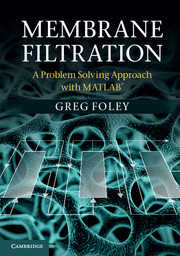Book contents
- Frontmatter
- Dedication
- Contents
- Preface
- Abbreviations
- 1 Introduction to membrane filtration of liquids
- 2 Dead-end filtration
- 3 Crossflow microfiltration
- 4 Ultrafiltration flux theories
- 5 Ultrafiltration process analysis and design at the limiting flux
- 6 Diafiltration at the limiting flux
- 7 Ultrafiltration and diafiltration with incomplete rejection
- 8 The osmotic pressure model applied to ultrafiltration and diafiltration
- 9 Reverse osmosis and nanofiltration
- 10 Membrane fouling
- Appendix Mathematical and computational background
- Index
- References
Appendix - Mathematical and computational background
Published online by Cambridge University Press: 05 July 2013
- Frontmatter
- Dedication
- Contents
- Preface
- Abbreviations
- 1 Introduction to membrane filtration of liquids
- 2 Dead-end filtration
- 3 Crossflow microfiltration
- 4 Ultrafiltration flux theories
- 5 Ultrafiltration process analysis and design at the limiting flux
- 6 Diafiltration at the limiting flux
- 7 Ultrafiltration and diafiltration with incomplete rejection
- 8 The osmotic pressure model applied to ultrafiltration and diafiltration
- 9 Reverse osmosis and nanofiltration
- 10 Membrane fouling
- Appendix Mathematical and computational background
- Index
- References
Summary
Introduction
A key part of the modelling and analysis of chemical and bioprocess engineering systems is the formulation of mass and/or energy balances. A large part of the skill of an engineer is his or her ability not only to state these balances in words, but more importantly, to express them in mathematical form. Once this has been done, the remainder of the problem is essentially one of applying well-established mathematical and/or computational techniques. In steady state processes, the system balances are in the form of systems of algebraic equations, usually non-linear in nature. An example is multi-stage continuous feed-and-bleed ultrafiltration that is covered in Chapter 5. In a batch process, the balances are usually formulated as systems of ordinary differential equations. An example is batch crossflow microfiltration that is covered in Chapter 3.
This book is aimed at a wide audience, from chemical engineers with a strong background in mathematics and computing, to students studying interdisciplinary subjects like biotechnology or bioprocessing who might be a little less mathematically literate. The aim of this appendix is to provide a brief summary of the main mathematical and computational techniques that are employed throughout the remainder of the text. Coverage of the mathematical topics is brief but provides the student with sufficient information that he or she can review the key topics in more depth using appropriate sections of their preferred mathematics text if desired. Coverage of the computational topics provides just enough background so that those who do not have a strong background in numerical methods will have some appreciation of how a computational tool such as MATLAB actually solves a system of differential or algebraic equations. Again, the student can consult a numerical methods text to obtain a deeper understanding of these topics if needed. However, this should not be necessary for the problems encountered in this book.
- Type
- Chapter
- Information
- Membrane FiltrationA Problem Solving Approach with MATLAB, pp. 299 - 322Publisher: Cambridge University PressPrint publication year: 2013



